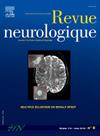Synapse and primary cilia dysfunctions in Autism Spectrum Disorders. Avenues to normalize these functions
IF 2.8
4区 医学
Q2 CLINICAL NEUROLOGY
引用次数: 0
Abstract
Aim
An update on the plasticity of the brain networks involved in autism (autism spectrum disorders [ASD]), and the increasing role of their synapses and primary non-motile cilia.
Methods
Data from PubMed and Google on this subject, published until February 2024, were analyzed.
Results
Structural and functional brain characteristics and genetic particularities involving synapses and cilia that modify neuronal circuits are observed in ASD, such as reduced pruning of dendrites, minicolumnar pathology, or persistence of connections usually doomed to disappear. Proteins involved in synapse functions (such as neuroligins and neurexins), in the postsynaptic architectural scaffolding (such as Shank proteins) or in cilia functions (such as IFT-independent kinesins) are often abnormal. There is an increase in glutaminergic transmission and a decrease in GABA inhibition. ASD may occur in genetic ciliopathies. The means of modulating these specificities, when deemed useful, are described.
Interpretation
The wide range of clinical manifestations of ASD is strongly associated with abnormalities in the morphology, functions, and plasticity of brain networks, involving their synapses and non-motile cilia. Their modulation offers important research perspectives on treatments when needed, especially since brain plasticity persists much later than previously thought. Improved early detection of ASD and additional studies on synapses and primary cilia are needed.
自闭症谱系障碍中的突触和初级纤毛功能障碍。使这些功能正常化的途径。
目的:更新自闭症(自闭症谱系障碍 [ASD])相关大脑网络的可塑性,以及其突触和初级非运动性纤毛所起的日益重要的作用:方法:分析了PubMed和Google上截至2024年2月发表的有关这一主题的数据:结果:在ASD患者中观察到了涉及突触和纤毛的大脑结构和功能特征以及改变神经元回路的遗传特异性,如树突修剪减少、小柱病理或通常注定消失的连接持续存在。参与突触功能的蛋白质(如神经ligins 和 neurexins)、参与突触后结构支架的蛋白质(如 Shank 蛋白)或参与纤毛功能的蛋白质(如不依赖于 IFT 的驱动蛋白)常常出现异常。谷氨酸传递增加,GABA 抑制减少。遗传性纤毛疾病也可能导致 ASD。在认为有用时,还介绍了调节这些特异性的方法:ASD的临床表现多种多样,与大脑网络的形态、功能和可塑性异常密切相关,涉及其突触和非运动性纤毛。对它们的调节为必要时的治疗提供了重要的研究视角,特别是因为大脑可塑性的持续时间比以前认为的要晚得多。我们需要加强对自闭症的早期检测,并对突触和初级纤毛进行更多的研究。
本文章由计算机程序翻译,如有差异,请以英文原文为准。
求助全文
约1分钟内获得全文
求助全文
来源期刊

Revue neurologique
医学-临床神经学
CiteScore
4.80
自引率
0.00%
发文量
598
审稿时长
55 days
期刊介绍:
The first issue of the Revue Neurologique, featuring an original article by Jean-Martin Charcot, was published on February 28th, 1893. Six years later, the French Society of Neurology (SFN) adopted this journal as its official publication in the year of its foundation, 1899.
The Revue Neurologique was published throughout the 20th century without interruption and is indexed in all international databases (including Current Contents, Pubmed, Scopus). Ten annual issues provide original peer-reviewed clinical and research articles, and review articles giving up-to-date insights in all areas of neurology. The Revue Neurologique also publishes guidelines and recommendations.
The Revue Neurologique publishes original articles, brief reports, general reviews, editorials, and letters to the editor as well as correspondence concerning articles previously published in the journal in the correspondence column.
 求助内容:
求助内容: 应助结果提醒方式:
应助结果提醒方式:


